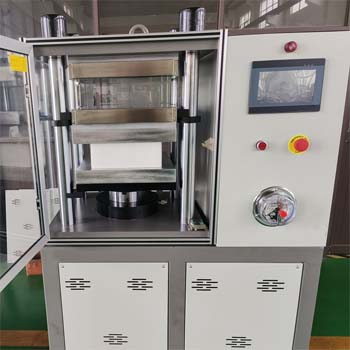Rubber vulcanization is a key process in the silicone ,rubber industries. This chemical vulcanization process need to add sulfur or other curing agents to rubber material and It turns raw rubber more harder and stronger .
Rubber vulcanization process is critical for rubber products such as O-ring ,tires, sealing parts, oil seal, auto parts ,crash pad, rubber air spring, key board, gasket and hoses.
As we all know , O-rings are critical sealing components widely used in various industries—from automotive and aerospace to chemical processing and medical devices. One of the most essential tools for producing high-quality O-rings is Vulcanizer Rubber Plate Vulcanizing Press Machine.
What Is a Vulcanizer Press?
A vulcanizer press machine is a equipment widely used to mold and cure rubber materials under heat and pressure. It typically consists of heating plate , beam and plate form , cylinder , base ,electrical system , etc .
Vulcanization is actually one chemical process that form cross-links between individual polymer chains in the rubber mateiral. Through vulcanization, it improves the elasticity, strength, and heat resistance therefore, it makes rubber material more resistant to heat, chemicals,
The O-Ring Production Process
But how does plate vulcanizer press equipment turn raw rubber into precision-sealed products?
Here’s Let’s explore how one laboratory vulcanizer press equipment typically works for O-ring manufacturing:
1. Mold Design and Preparation
To begin the vulcanization process ,firstly ,you need to design one suitable mold that matches the dimensions of the desired O-ring ( including inner diameter, outer diameter, and cross-section). The mold is usually made of high-strength steel , and it consists of a top and bottom plate that fits into the vulcanizer press.
2. Rubber Loading
Then , place the raw rubber into the mold of vulcanizer press equipment . This raw rubber is often mixed and blender with curing agents and fillers (e.g., NBR, EPDM, FKM) for further vulcanization process.
3. Pressing and Heating
The mold is then closed inside the vulcanizer press equipment,which apply high pressure (often 10–20 MPa) and heats uniform and heats ( between 140–180°C). The agents would activates the vulcanization process on the rubber material .
4. Curing Time
Usually ,the curing time is different for different material. Take example ,for O-ring , the vulcanization process take ranges from 4 to 11 minutes. During this vulcanization time, the rubber flows, fills the mold cavity, and undergoes chemical cross-linking action to produce its final designed elastic properties.
5. Demolding and Trimming
When the curing process is finished, the mold would be opened and the O-rings need to removed , then go into next steps ,cooled, inspected, and often trimmed to remove flash—excess material squeezed out of the mold during pressing.
Advantages of Vulcanizer Press for O-Ring Production
* High precision: Ensures dimensional accuracy and tight tolerances.
* Excellent repeatability: Consistent results batch after batch.
* Material versatility: Compatible with a wide range of rubber compounds.
* Customization: Molds can be easily adapted for various O-ring sizes and profiles.
In one word ,a vulcanizer press equipment is an essential machine in the production of high-quality O-rings. By combining precise mold design, controlled pressure, and heat, the lab vulcanizer press machine enables manufacturers to produce durable, flexible seals that meet strict industry standards. Whether for high-temperature engines or delicate medical devices, vulcanized O-rings deliver performance where it matters most.
Simptek , as a leading rubber processing equipment manufacturer. We offers advanced and reliable plate vulcanizer press equipmen, which ensure high performance and product quality. If you have any questions, welcome to contact our expert engineers now.







